An Augmented Modulated Deep Learning Based Intelligent Predictive Model for Brain Tumor Detection Using GAN Ensemble
Abstract
1. Introduction
Research Gap and Motivation
- In this research analysis, an integrated performance evaluation of different popular GAN approaches is done in the context of brain tumor symptom detection.
- This study proposes a novel augmented modulated deep learning-based advanced predictive model utilizing the voting-based GAN ensemble for the early detection of brain tumors.
- Enhanced hybrid CNN model with PGGAN architecture produced the best outcome recording, i.e., an optimum accuracy, precision, recall, F1-Score, and NPV of 98.85, 98.45%, 97.2%, 98.11%, and 98.09%, respectively. Additionally, the least time latency of 3.4 s is noted with the proposed hybrid model.
- The outcome of the implementation analysis through various performance parameters demonstrates that PGGAN is the most suitable augmented method for data generation with sufficient diversity in comparison with other GANs.
2. Literature Review and Background Study
2.1. Relevant Research in Context to Machine Learning (ML) for Brain Tumor Analysis
2.2. Relevant Research in Context to Deep Learning for Brain Tumor Analysis
3. Working Principle of GAN
4. Materials and Methods
4.1. Dataset Used in the Study
4.2. System Configuration
4.3. Proposed Methodology
4.3.1. Pre-Processing Algorithm for the Skull Stripping
4.3.2. Pre-Processing Algorithm for the MRI Picture Contrast Improvement
4.3.3. Classification Using Modulated-CNN
5. Implementation Results and Discussion
6. Conclusions and Future Scope
Author Contributions
Funding
Institutional Review Board Statement
Informed Consent Statement
Data Availability Statement
Conflicts of Interest
References
- Kang, J.; Ullah, Z.; Gwak, J. MRI-Based Brain Tumor Classification Using Ensemble of Deep Features and Machine Learning Classifiers. Sensors 2021, 21, 2222. [Google Scholar] [CrossRef] [PubMed]
- Amin, J.; Sharif, M.; Haldorai, A.; Yasmin, M.; Nayak, R.S. Brain tumor detection and classification using machine learning: A comprehensive survey. Complex Intell. Syst. 2021, 8, 3161–3183. [Google Scholar] [CrossRef]
- Mishra, S.; Panda, A.; Tripathy, K.H. Implementation of re-sampling technique to handle skewed data in tumor prediction. J. Adv. Res. Dyn. Control Syst. 2018, 10, 526–530. [Google Scholar]
- Kumar, T.S.; Arun, C.; Ezhumalai, P. An approach for brain tumor detection using optimal feature selection and optimized deep belief network. Biomed. Signal Process. Control. 2022, 73, 103440. [Google Scholar] [CrossRef]
- Aastha; Mishra, S.; Mohanty, S. Integration of Machine Learning and IoT for Assisting Medical Experts in Brain Tumor Diagnosis. In Smart Healthcare Analytics: State of the Art; Springer: Singapore, 2022; pp. 133–164. [Google Scholar] [CrossRef]
- Ma, L.; Zhang, F. End-to-end predictive intelligence diagnosis in brain tumor using lightweight neural network. Appl. Soft Comput. 2022, 111, 107666. [Google Scholar] [CrossRef]
- Senan, E.M.; Jadhav, M.E.; Rassem, T.H.; Aljaloud, A.S.; Mohammed, B.A.; Al-Mekhlafi, Z.G. Early Diagnosis of Brain Tumour MRI Images Using Hybrid Techniques between Deep and Machine Learning. Comput. Math. Methods Med. 2022, 2022, 8330833. [Google Scholar] [CrossRef] [PubMed]
- Ramtekkar, P.K.; Pandey, A.; Pawar, M.K. Accurate detection of brain tumor using optimized feature selection based on deep learning techniques. Multimedia Tools Appl. 2023, 2, 1–31. [Google Scholar] [CrossRef]
- Haq, A.U.; Li, J.P.; Khan, S.; Alshara, M.A.; Alotaibi, R.M.; Mawuli, C. DACBT: Deep learning approach for classification of brain tumors using MRI data in IoT healthcare environment. Sci. Rep. 2022, 12, 15331. [Google Scholar] [CrossRef]
- Shelatkar, T.; Urvashi; Shorfuzzaman, M.; Alsufyani, A.; Lakshmanna, K. Diagnosis of Brain Tumor Using Light Weight Deep Learning Model with Fine-Tuning Approach. Comput. Math. Methods Med. 2022, 2022, 2858845. [Google Scholar] [CrossRef]
- Saeedi, S.; Rezayi, S.; Keshavarz, H.; Kalhori, S.R.N. MRI-based brain tumor detection using convolutional deep learning methods and chosen machine learning techniques. BMC Med. Informatics Decis. Mak. 2023, 23, 16. [Google Scholar] [CrossRef]
- Keerthana, A.; Kumar, B.K.; Akshaya, K.; Kamalraj, S. Brain Tumour Detection Using Machine Learning Algorithm. J. Physics: Conf. Ser. 2021, 1937, 012008. [Google Scholar] [CrossRef]
- Sarkar, A.; Maniruzzaman; Alahe, M.A.; Ahmad, M. An Effective and Novel Approach for Brain Tumor Classification Using AlexNet CNN Feature Extractor and Multiple Eminent Machine Learning Classifiers in MRIs. J. Sensors 2023, 2023, 1224619. [Google Scholar] [CrossRef]
- Akinyelu, A.A.; Zaccagna, F.; Grist, J.T.; Castelli, M.; Rundo, L. Brain Tumor Diagnosis Using Machine Learning, Convolutional Neural Networks, Capsule Neural Networks and Vision Transformers, Applied to MRI: A Survey. J. Imaging 2022, 8, 205. [Google Scholar] [CrossRef] [PubMed]
- Mahmud, I.; Mamun, M.; Abdelgawad, A. A Deep Analysis of Brain Tumor Detection from MR Images Using Deep Learning Networks. Algorithms 2023, 16, 176. [Google Scholar] [CrossRef]
- Mehnatkesh, H.; Jalali, S.M.J.; Khosravi, A.; Nahavandi, S. An intelligent driven deep residual learning framework for brain tumor classification using MRI images. Expert Syst. Appl. 2023, 213, 119087. [Google Scholar] [CrossRef]
- Methil, A.S. Brain Tumor Detection using Deep Learning and Image Processing. In Proceedings of the International Conference on Artificial Intelligence and Smart Systems, ICAIS 2021, Coimbatore, India, 25–27 March 2021. [Google Scholar]
- Shinde, A.S.; Mahendra, B.; Nejakar, S.; Herur, S.M.; Bhat, N. Performance analysis of machine learning algorithm of detection and classification of brain tumor using computer vision. Adv. Eng. Softw. 2022, 173, 103221. [Google Scholar] [CrossRef]
- Chen, B.; Zhang, L.; Chen, H.; Liang, K.; Chen, X. A novel extended Kalman filter with support vector machine based method for the automatic diagnosis and segmentation of brain tumors. Comput. Methods Programs Biomed. 2020, 200, 105797. [Google Scholar] [CrossRef] [PubMed]
- Islam, K.; Ali, S.; Miah, S.; Rahman, M.; Alam, S.; Hossain, M.A. Brain tumor detection in MR image using superpixels, principal component analysis and template based K-means clustering algorithm. Mach. Learn. Appl. 2021, 5, 100044. [Google Scholar] [CrossRef]
- Vankdothu, R.; Hameed, M.A. Brain tumor segmentation of MR images using SVM and fuzzy classifier in machine learning. Meas. Sensors 2022, 24, 100440. [Google Scholar] [CrossRef]
- Gajula, S.; Rajesh, V. An MRI brain tumour detection using logistic regression-based machine learning model. Int. J. Syst. Assur. Eng. Manag. 2022, 3, 1–11. [Google Scholar] [CrossRef]
- Saba, S.S.; Sreelakshmi, D.; Kumar, P.S.; Kumar, K.S.; Saba, S.R. Logistic regression machine learning algorithm on MRI brain image for fast and accurate diagnosis. Int. J. Sci. Technol. Res. 2020, 9, 7076–7081. [Google Scholar]
- Osman, A.F.I. Automated Brain Tumor Segmentation on Magnetic Resonance Images and Patient’s Overall Survival Prediction Using Support Vector Machines. In Proceedings of the Brainlesion: Glioma, Multiple Sclerosis, Stroke and Traumatic Brain Injuries: Third International Workshop, BrainLes 2017, Quebec City, QC, Canada, 14 September 2017; Springer International Publishing: Cham, Switzerland, 2018; pp. 435–449. [Google Scholar]
- Felefly, T.; Achkar, S.; Lteif, T.; Azoury, F.; Khoury, C.; Sayah, R.; Barouky, J.; Farah, N.; Nasr, D.N.; Nasr, E. A Machine-Learning Model using MRI-based Radiomic Features to Predict Primary Site for Brain Metastases. Int. J. Radiat. Oncol. 2019, 105, E141. [Google Scholar] [CrossRef]
- Jeong, J.J.; Ji, B.; Lei, Y.; Wang, L.; Liu, T.; Ali, A.N.; Curran, W.J.; Mao, H.; Yang, X. Machine-learning based classification of glioblastoma using dynamic susceptibility enhanced MR image. In Proceedings of the Medical Imaging 2019: Biomedical Applications in Molecular, Structural, and Functional Imaging, San Diego, CA, USA, 16–21 February 2019; SPIE: San Diego, CA, USA, 2019. [Google Scholar] [CrossRef]
- Kiranmayee, B.V.; Rajinikanth, T.V.; Nagini, S. Enhancement of SVM based MRI Brain Image Classification using Pre-Processing Techniques. Indian J. Sci. Technol. 2016, 9, 1–7. [Google Scholar] [CrossRef]
- Sharif, M.; Amin, J.; Raza, M.; Anjum, M.A.; Afzal, H.; Shad, S.A. Brain tumor detection based on extreme learning. Neural Comput. Appl. 2020, 32, 15975–15987. [Google Scholar] [CrossRef]
- Anitha, R.; Raja, D.S.S. Development of computer-aided approach for brain tumor detection using random forest classifier. Int. J. Imaging Syst. Technol. 2018, 28, 48–53. [Google Scholar] [CrossRef]
- Asodekar, B.H.; Gore, S.A.; Thakare, A.D. Brain Tumor analysis Based on Shape Features of MRI using Machine Learning. In Proceedings of the 2019 5th International Conference on Computing, Communication, Control and Automation (ICCUBEA), Pune, India, 19–21 September 2019. [Google Scholar] [CrossRef]
- Gyorfi, A.; Csaholczi, S.; Fulop, T.; Kovacs, L.; Szilagyi, L. Brain Tumor Segmentation from Multi-Spectral Magnetic Resonance Image Data Using an Ensemble Learning Approach. In Proceedings of the IEEE International Conference on Systems, Man and Cybernetics, Toronto, ON, Canada, 11–14 October 2020. [Google Scholar] [CrossRef]
- Seere, S.K.H.; Karibasappa, K. Threshold Segmentation and Watershed Segmentation Algorithm for Brain Tumor Detection using Support Vector Machine. Eur. J. Eng. Res. Sci. 2020, 5, 516–519. [Google Scholar] [CrossRef]
- Kharat, K.; Kulkarni, P.P. Brain Tumor Classification Using Neural Network Based Methods. Int. J. Comput. Sci. Informatics 2012, 1, 2231–5292. [Google Scholar] [CrossRef]
- Qasem, S.N.; Nazar, A.; Qamar, A.; Shamshirband, S. A Learning Based Brain Tumor Detection System. Comput. Mater. Contin. 2019, 59, 713–727. [Google Scholar] [CrossRef]
- Selvapandian, A.; Manivannan, K. Performance analysis of meningioma brain tumor classifications based on gradient boosting classifier. Int. J. Imaging Syst. Technol. 2018, 28, 295–301. [Google Scholar] [CrossRef]
- Biradar, C. Measurement based Human Brain Tumor Recognition by Adapting Support Vector Machine. IOSR J. Eng. 2013, 3, 26–31. [Google Scholar] [CrossRef]
- Ajai, A.S.R.; Gopalan, S. Analysis of Active Contours Without Edge-Based Segmentation Technique for Brain Tumor Classification Using SVM and KNN Classifiers. In Advances in Communication Systems and Networks: Select Proceedings of ComNet 2019; Springer: Singapore, 2020. [Google Scholar] [CrossRef]
- Anantharajan, S.; Gunasekaran, S. Detection and Classification of MRI Brain Tumour Using GLCM and Enhanced K-NN. Comptes Rendus Acad. Bulg. Des Sci. 2021, 74, 260–268. [Google Scholar] [CrossRef]
- Rajagopal, R. Glioma brain tumor detection and segmentation using weighting random forest classifier with optimized ant colony features. Int. J. Imaging Syst. Technol. 2019, 29, 353–359. [Google Scholar] [CrossRef]
- Divyamary, D.; Gopika, S.; Pradeeba, S.; Bhuvaneswari, M. Brain Tumor Detection from MRI Images using Naive Classifier. In Proceedings of the 2020 6th International Conference on Advanced Computing and Communication Systems (ICACCS), Coimbatore, India, 6–7 March 2020. [Google Scholar] [CrossRef]
- Aswathy, A.L.; Chandra, S.S.V. Detection of Brain Tumor Abnormality from MRI FLAIR Images using Machine Learning Techniques. J. Inst. Eng. (India) Ser. B 2022, 103, 1097–1104. [Google Scholar] [CrossRef]
- Brindha, P.G.; Kavinraj, M.; Manivasakam, P.; Prasanth, P. Brain tumor detection from MRI images using deep learning techniques. IOP Conf. Series: Mater. Sci. Eng. 2021, 1055, 012115. [Google Scholar] [CrossRef]
- Kulkarni, S.M.; Sundari, G. A Framework for Brain Tumor Segmentation and Classification using Deep Learning Algorithm. Int. J. Adv. Comput. Sci. Appl. 2020, 11, 374–382. [Google Scholar] [CrossRef]
- Jia, Z.; Chen, D. Brain Tumor Identification and Classification of MRI images using deep learning techniques. IEEE Access 2020, 2, 1. [Google Scholar] [CrossRef]
- Suganya, M.; Sabitha, R.; Jasmine, J.A. Deep learning technique for brain tumor detection using medical image fusion. Int. J. Innov. Technol. Explor. Eng. 2019, 8, 867–870. [Google Scholar]
- Selvy, P.T.; Dharani, V.P.; Indhuja, A. Brain Tumour Detection Using Deep Learning Techniques. Int. J. Sci. Res. Comput. Sci. Eng. Inf. Technol. 2019, 169, 175. [Google Scholar] [CrossRef]
- Kumar, A.; Manikandan, R.; Rahim, R. A Study on Brain Tumor Detection and Segmentation Using Deep Learning Techniques. J. Comput. Theor. Nanosci. 2020, 17, 1925–1930. [Google Scholar] [CrossRef]
- Bathe, K.; Rana, V.; Singh, S.; Singh, V. Brain Tumor Detection Using Deep Learning Techniques. SSRN Electron. J. 2021, 4, 1–5. [Google Scholar] [CrossRef]
- Aamir, M.; Rahman, Z.; Dayo, Z.A.; Abro, W.A.; Uddin, M.I.; Khan, I.; Imran, A.S.; Ali, Z.; Ishfaq, M.; Guan, Y.; et al. A deep learning approach for brain tumor classification using MRI images. Comput. Electr. Eng. 2022, 101, 108105. [Google Scholar] [CrossRef]
- Sajjad, M.; Khan, S.; Muhammad, K.; Wu, W.; Ullah, A.; Baik, S.W. Multi-grade brain tumor classification using deep CNN with extensive data augmentation. J. Comput. Sci. 2019, 30, 174–182. [Google Scholar] [CrossRef]
- Yogananda, C.G.B.; Shah, B.R.; Vejdani-Jahromi, M.; Nalawade, S.S.; Murugesan, G.K.; Yu, F.F.; Pinho, M.C.; Wagner, B.C.; Emblem, K.E.; Bjørnerud, A.; et al. A Fully Automated Deep Learning Network for Brain Tumor Segmentation. Tomography 2020, 6, 186–193. [Google Scholar] [CrossRef] [PubMed]
- Noreen, N.; Palaniappan, S.; Qayyum, A.; Ahmad, I.; Imran, M.; Shoaib, M. A Deep Learning Model Based on Concatenation Approach for the Diagnosis of Brain Tumor. IEEE Access 2020, 8, 55135–55144. [Google Scholar] [CrossRef]
- Dipu, N.M.; Shohan, S.A.; Salam, K.M.A. Deep Learning Based Brain Tumor Detection and Classification. In Proceedings of the 2021 International Conference on Intelligent Technologies CONIT 2021, Hubli, India, 25–27 June 2021. [Google Scholar]
- Huang, H.; Yang, G.; Zhang, W.; Xu, X.; Yang, W.; Jiang, W.; Lai, X. A Deep Multi-Task Learning Framework for Brain Tumor Segmentation. Front. Oncol. 2021, 11, 690244. [Google Scholar] [CrossRef]
- Suganthe, R.C.; Revathi, G.; Monisha, S.; Pavithran, R. Deep learning based brain tumor classification using magnetic resonance imaging. J. Crit. Rev. 2020, 7, 347–350. [Google Scholar]
- Rehman, A.; Naz, S.; Razzak, M.I.; Akram, F.; Imran, M. A Deep Learning-Based Framework for Automatic Brain Tumors Classification Using Transfer Learning. Circuits Syst. Signal Process. 2020, 39, 757–775. [Google Scholar] [CrossRef]
- Shivdikar, A.; Shirke, M.; Vodnala, I.; Upadhaya, J. Brain Tumor Detection using Deep Learning. Int. J. Res. Appl. Sci. Eng. Technol. 2022, 10, 621–627. [Google Scholar] [CrossRef]
- Alsubai, S.; Khan, H.U.; Alqahtani, A.; Sha, M.; Abbas, S.; Mohammad, U.G. Ensemble deep learning for brain tumor detection. Front. Comput. Neurosci. 2022, 16, 1005617. [Google Scholar] [CrossRef]
- Alanazi, M.F.; Ali, M.U.; Hussain, S.J.; Zafar, A.; Mohatram, M.; Irfan, M.; AlRuwaili, R.; Alruwaili, M.; Ali, N.H.; Albarrak, A.M. Brain Tumor/Mass Classification Framework Using Magnetic-Resonance-Imaging-Based Isolated and Developed Transfer Deep-Learning Model. Sensors 2022, 22, 372. [Google Scholar] [CrossRef]
- Cheng, J. Brain Tumor Dataset. 2017. Available online: https://figshare.com/articles/dataset/brain_tumor_dataset/1512427/5 (accessed on 10 September 2017).
- Raja, P.S.; Rani, A.V. Brain tumor classification using a hybrid deep autoencoder with Bayesian fuzzy clustering-based segmentation approach. Biocybern. Biomed. Eng. 2020, 40, 440–453. [Google Scholar] [CrossRef]
- Adu, K.; Yu, Y.; Cai, J.; Tashi, N. Dilated Capsule Network for Brain Tumor Type Classification Via MRI Segmented Tumor Region. In Proceedings of the 2019 IEEE International Conference on Robotics and Biomimetics (ROBIO), Dali, China, 6–8 December 2019. [Google Scholar] [CrossRef]
- Vankdothu, R.; Hameed, M.A. Brain tumor MRI images identification and classification based on the recurrent convolutional neural network. Meas. Sensors 2022, 24, 100412. [Google Scholar] [CrossRef]
- Seetha, J.; Raja, S.S. Brain Tumor Classification Using Convolutional Neural Networks. Biomed. Pharmacol. J. 2018, 11, 1457–1461. [Google Scholar] [CrossRef]
- Younis, A.; Qiang, L.; Nyatega, C.O.; Adamu, M.J.; Kawuwa, H.B. Brain Tumor Analysis Using Deep Learning and VGG-16 Ensembling Learning Approaches. Appl. Sci. 2022, 12, 7282. [Google Scholar] [CrossRef]
- Sethy, P.K.; Behera, S.K. A data constrained approach for brain tumour detection using fused deep features and SVM. Multimedia Tools Appl. 2021, 80, 28745–28760. [Google Scholar] [CrossRef]
- Lamrani, D.; Cherradi, B.; El Gannour, O.; Bouqentar, M.A.; Bahatti, L. Brain Tumor Detection using MRI Images and Convolutional Neural Network. Int. J. Adv. Comput. Sci. Appl. 2022, 13, 452–460. [Google Scholar] [CrossRef]
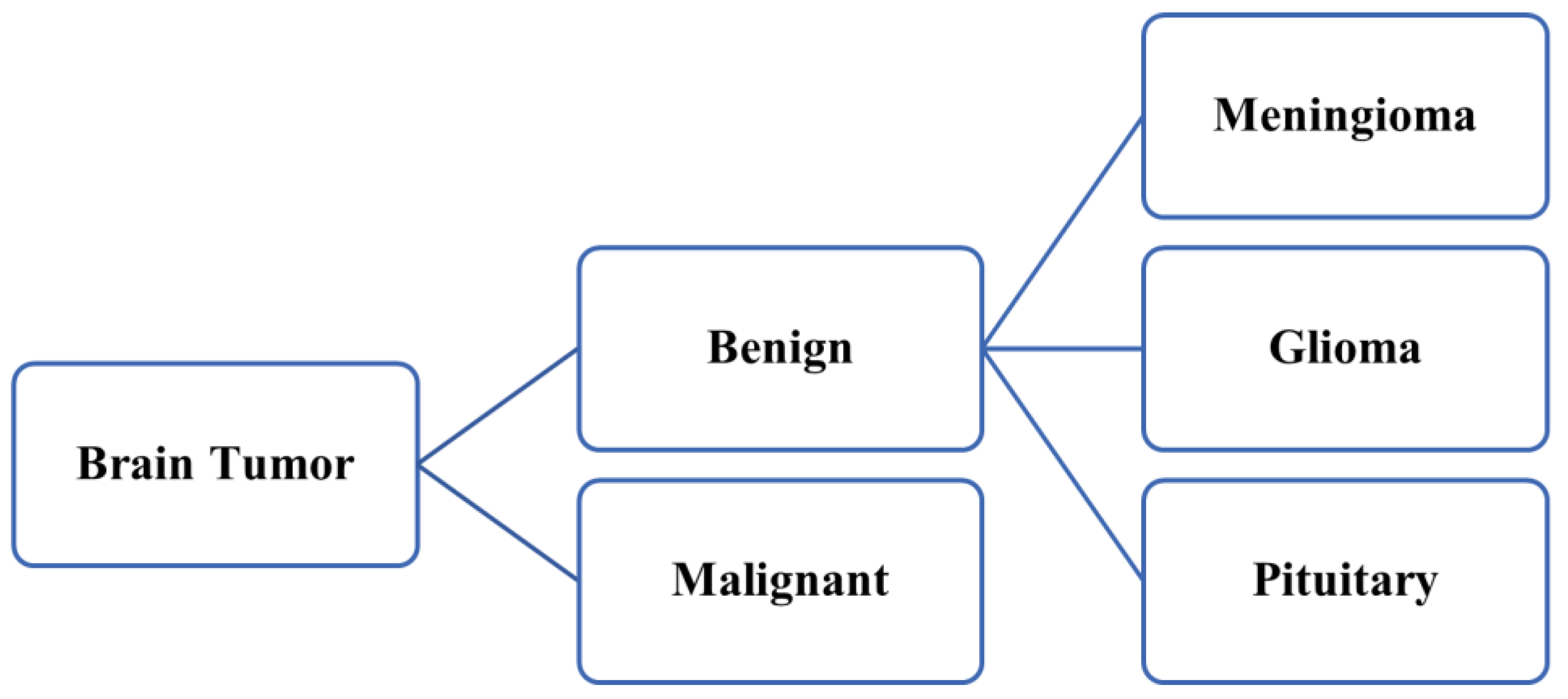
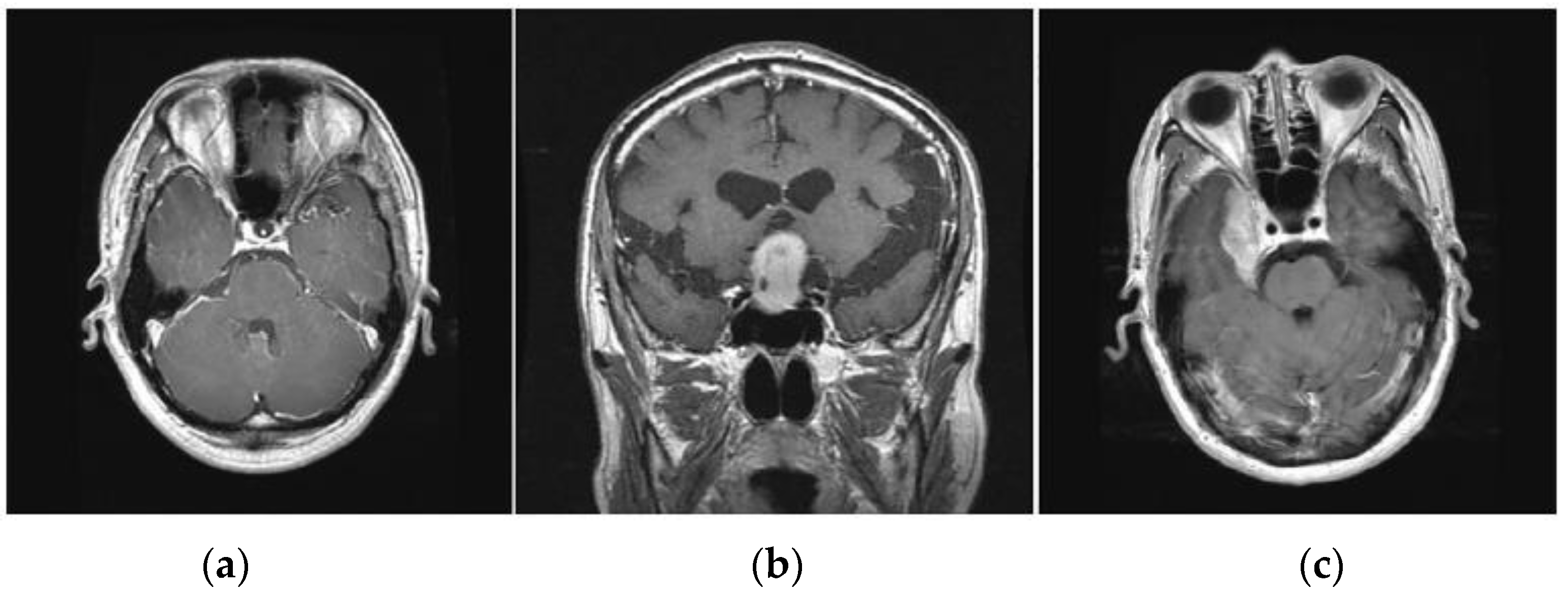

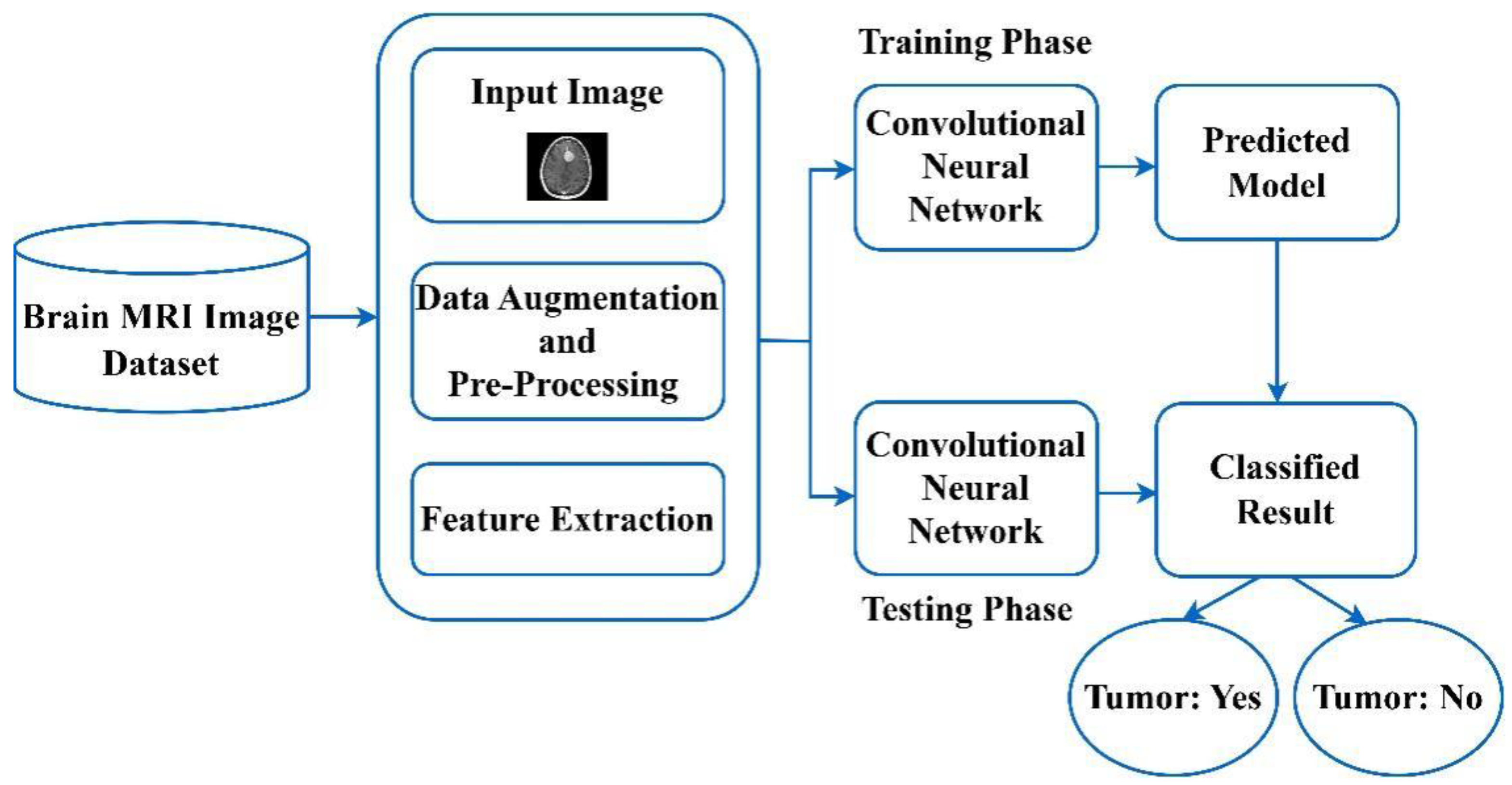
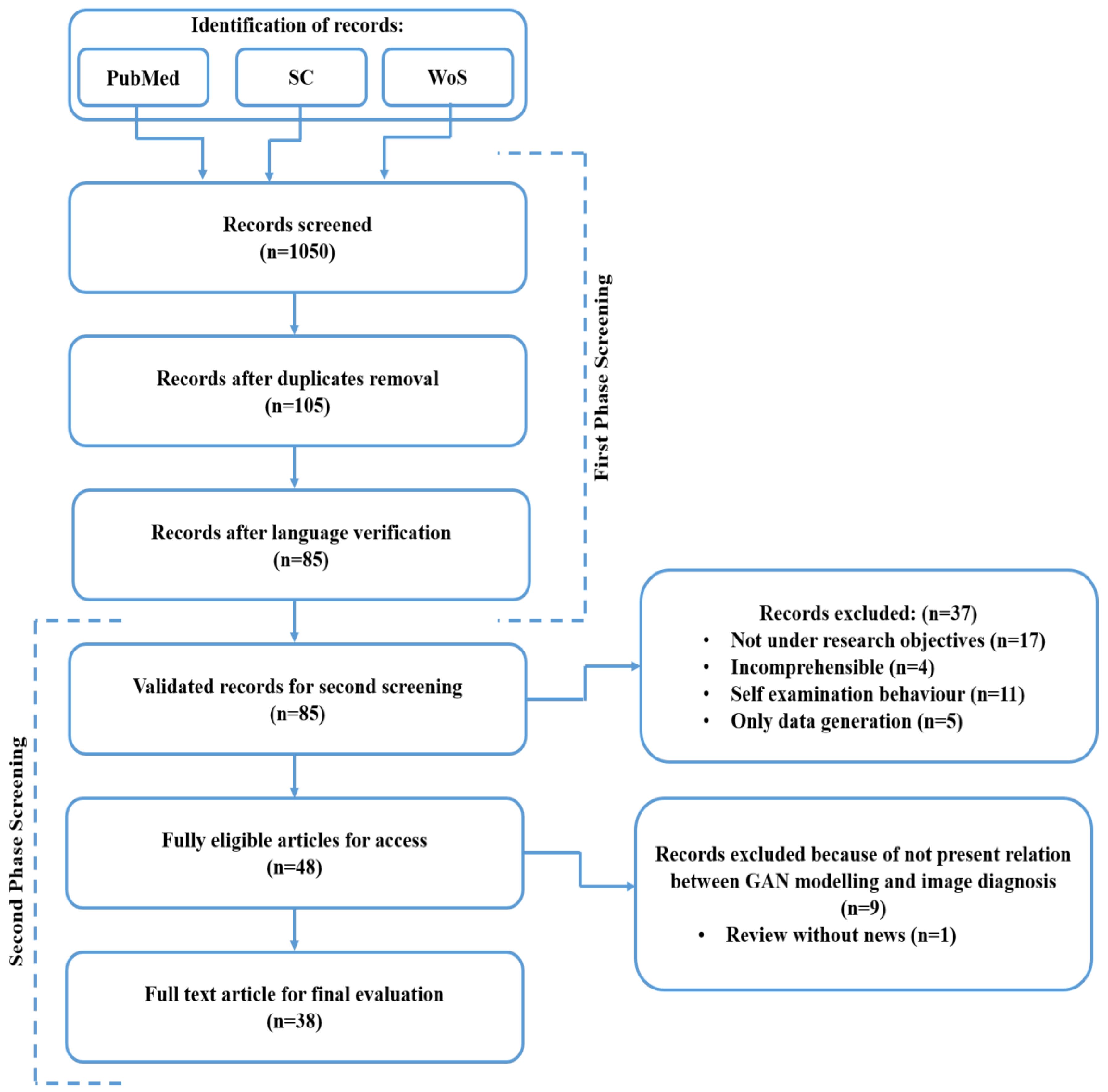
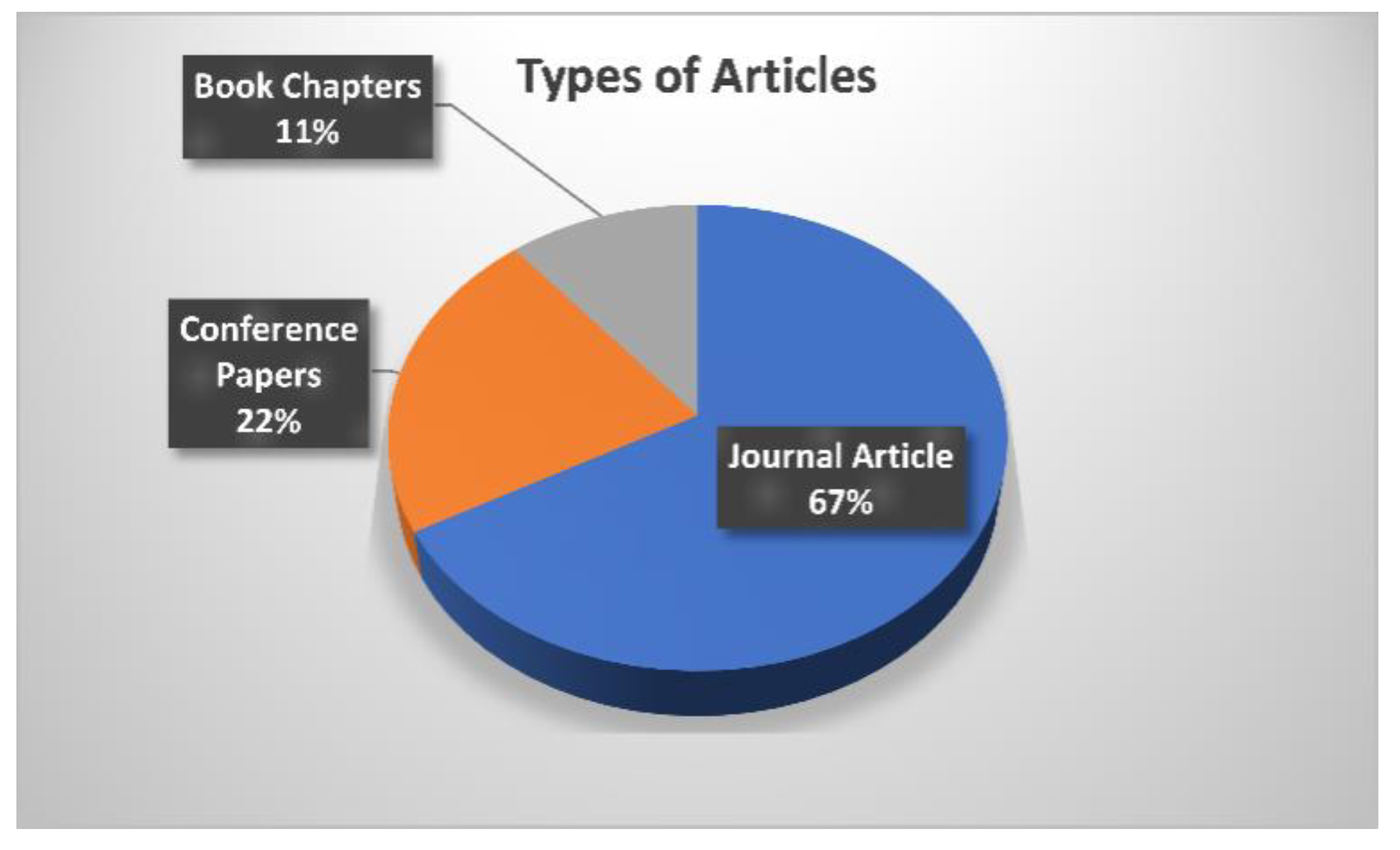

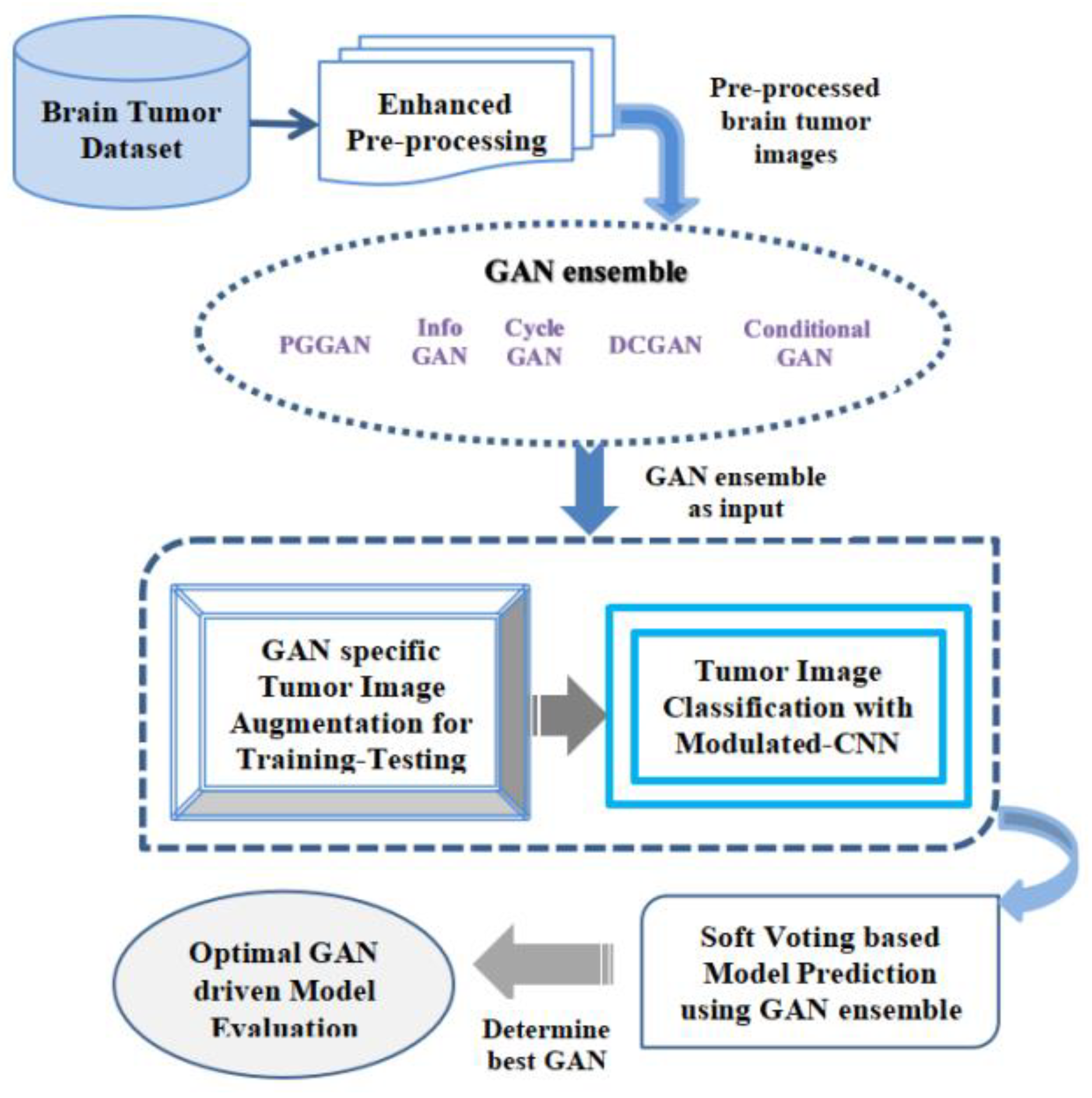

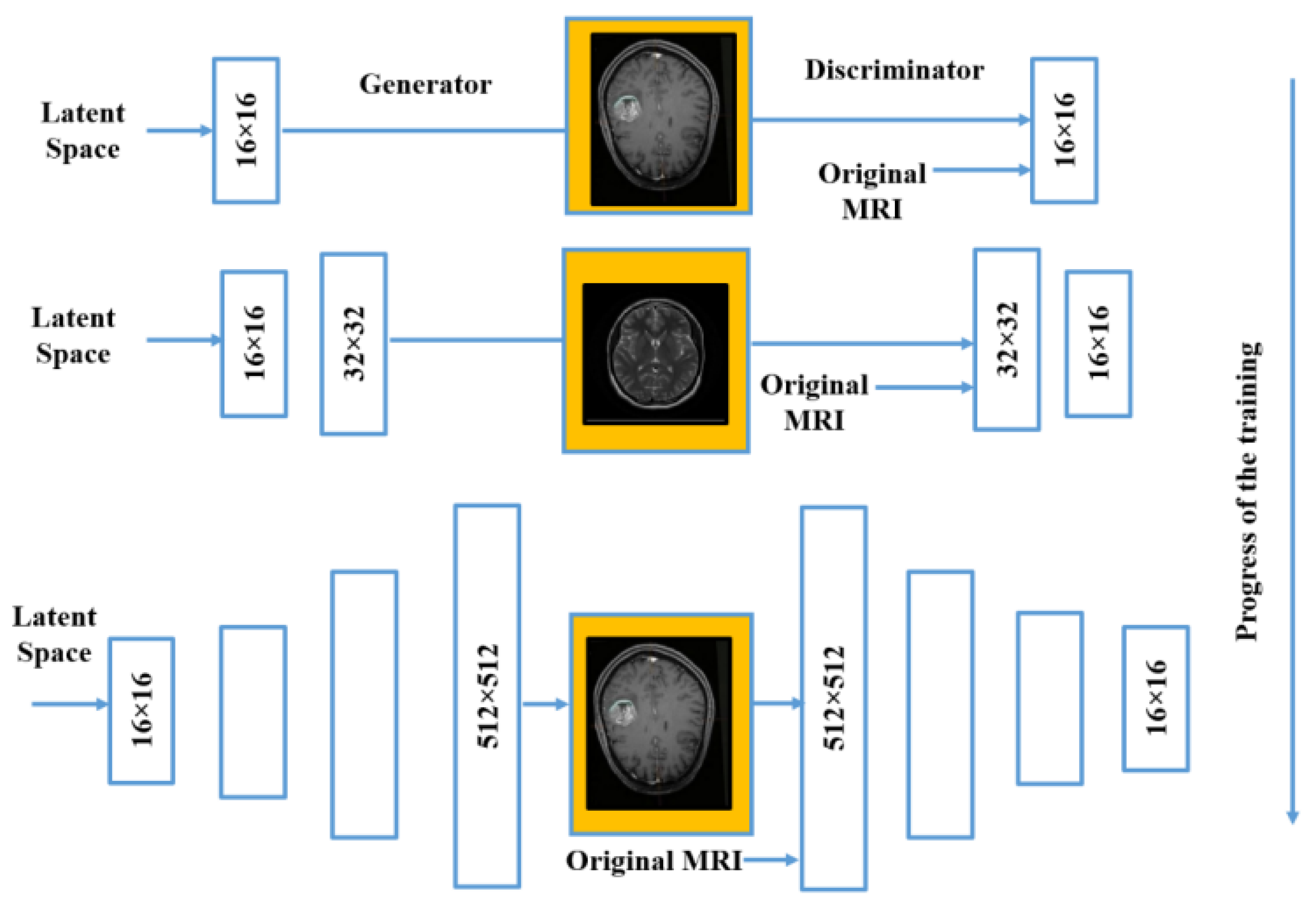

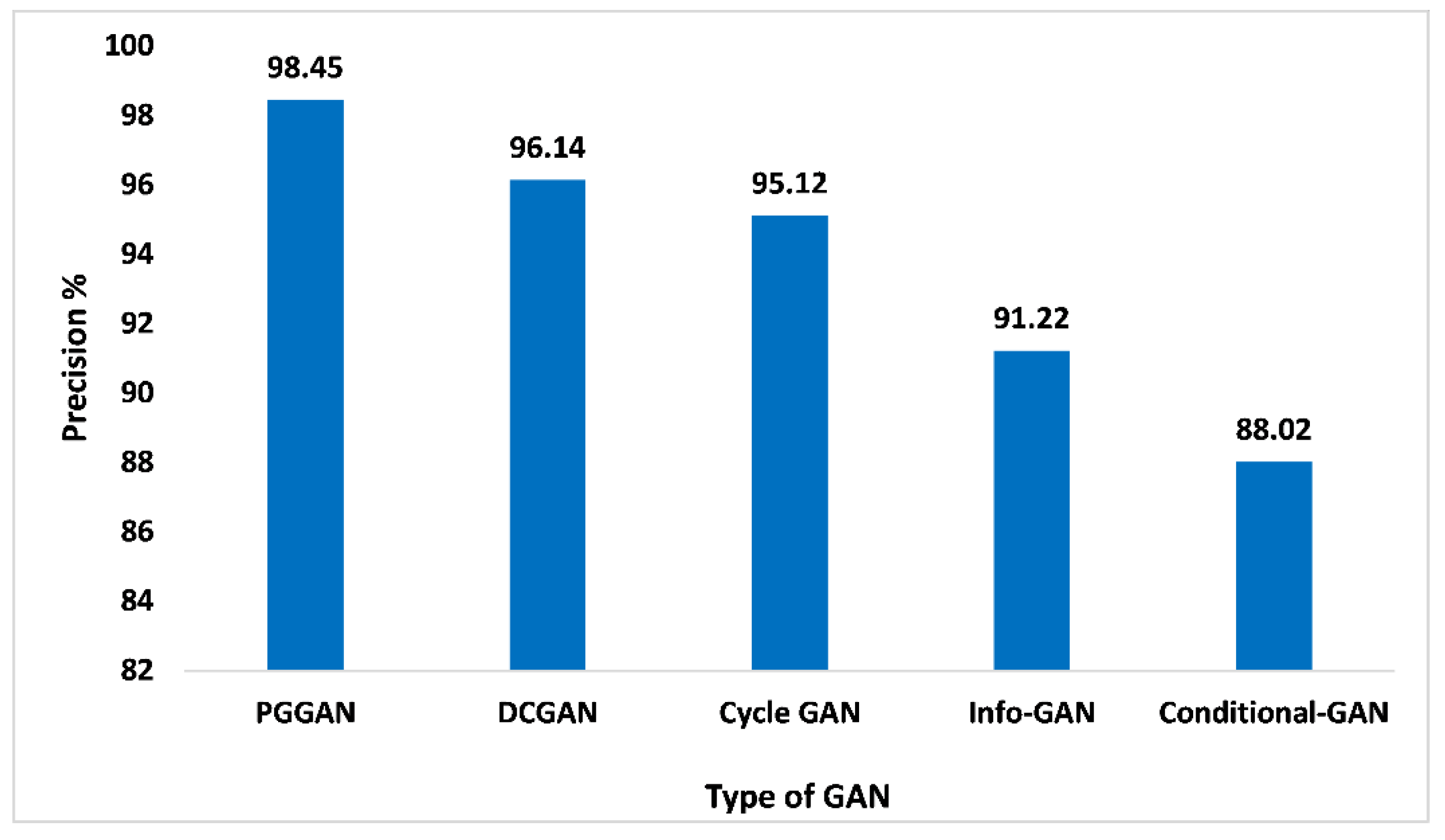
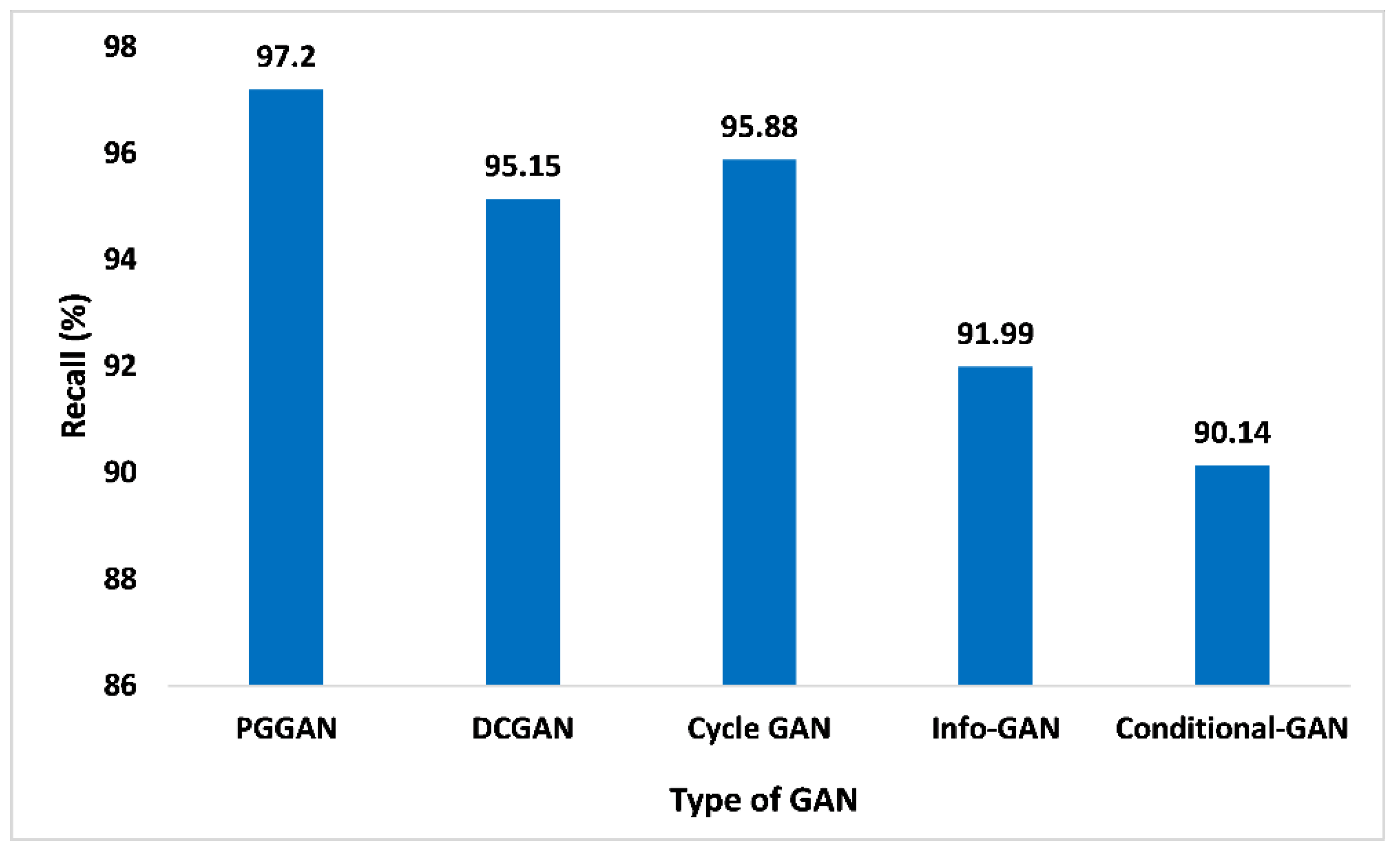

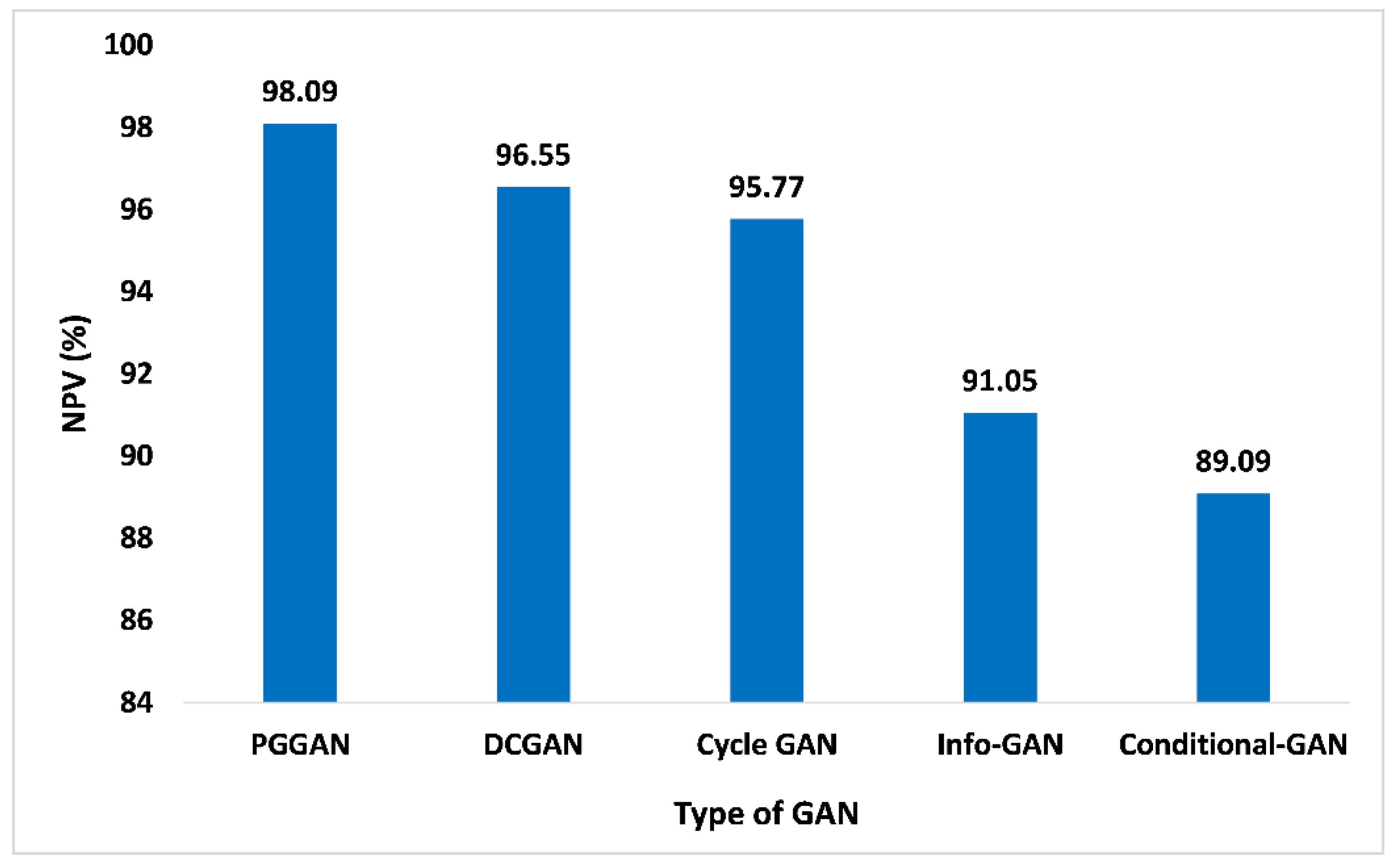
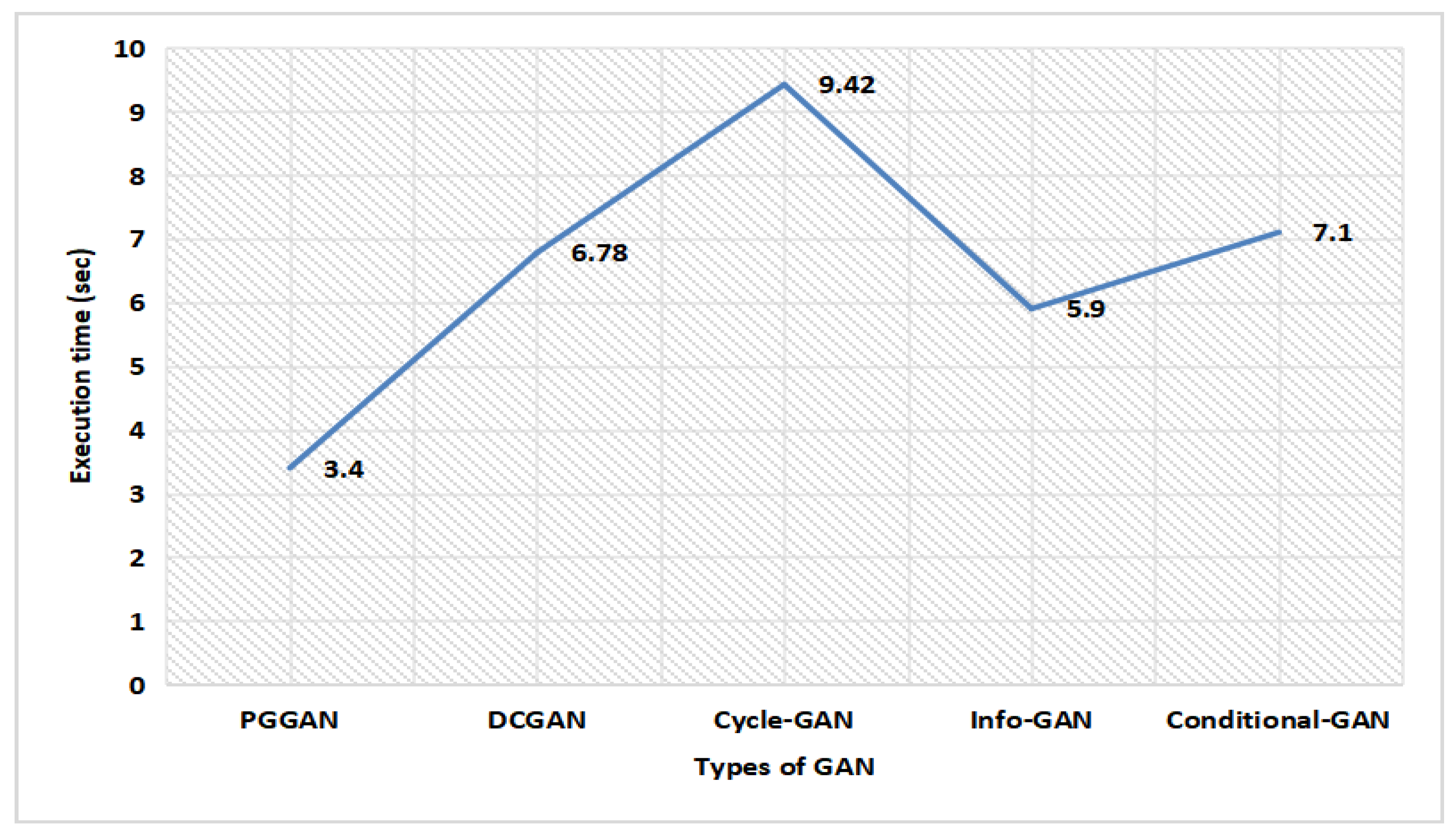
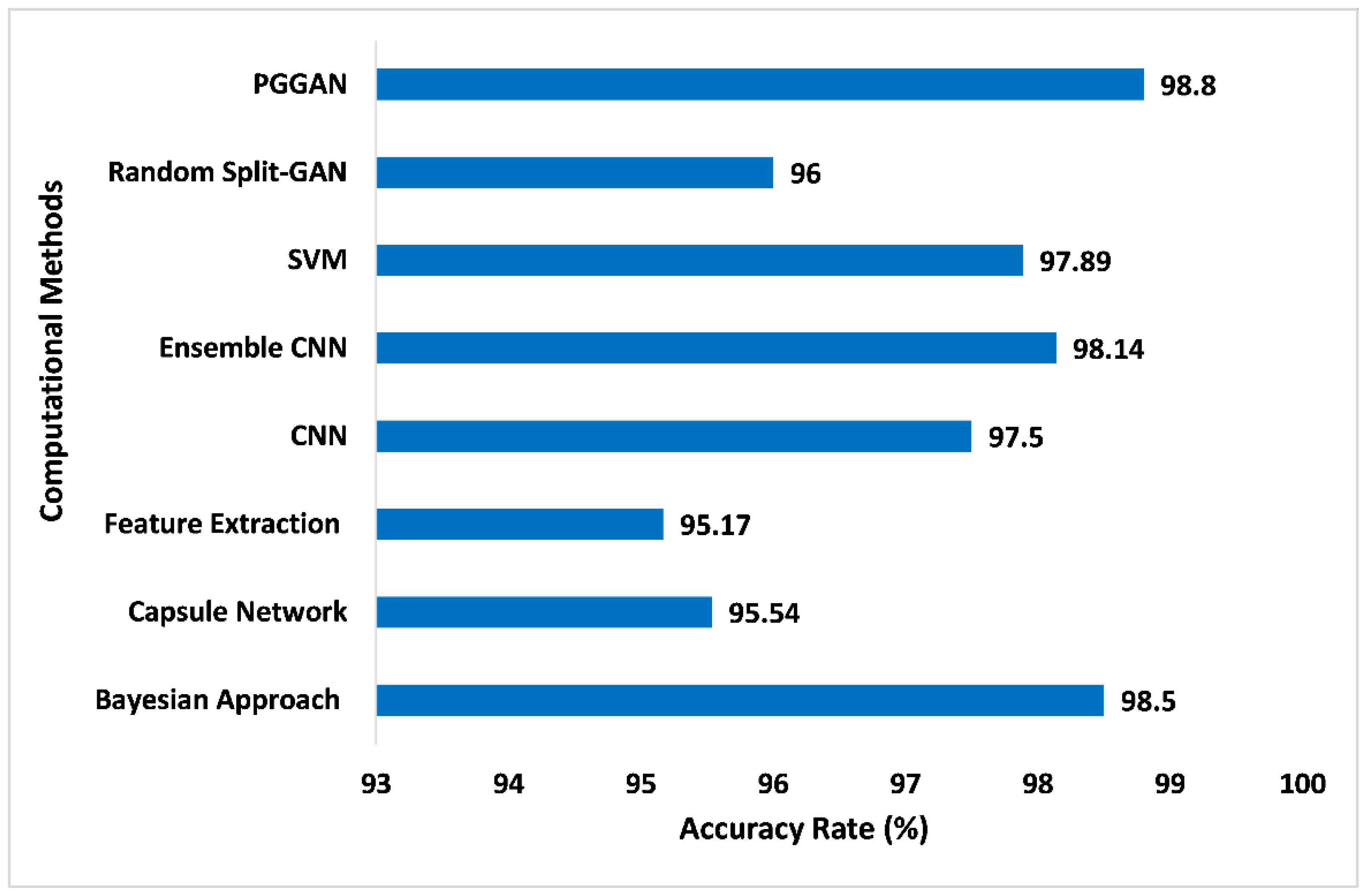
| Methodology Utilized | Novelty | Benefits | Limitations |
|---|---|---|---|
| In this article, the authors conducted an experiment for performance computation of numerous ML algorithms for effective categorization of brain tumors [18]. | It is found that multilayer perceptron along with logistic regression provides the optimized outcomes for segmentation and classification tasks. | Improved diagnosis, enhanced planning of patient’s treatment, as well as usages of multimodal information. | Selection of the ideal features for recognition of the diverse classes seems to be a more complex as well as time taking procedure due to the lack of generalization possibilities. |
| In this article, the authors adapted the Extended Kalman Filter (EKF) as well as SVM to determine the brain tissues automatically [19]. | This novel model ensemble an Extended Kalman Filter (EKF) as well as Support Vector Machine (SVM) to categorize brain tumors in MR images. | Better classification performance for positive brain tumor images, automatic diagnosis as well as effective segmentation. | Possibilities of misclassification in the categorization procedure. Additionally, the present approach is computationally more complex owing to the usage of conventional region-growing algorithms. |
| In this work, the authors proposed an improved brain tumor classification approach using a template-based K-means (TBK) algorithm [20]. | Initially, the important features were extracted utilizing the super pixels as well as principal component analysis (PCA) that aids to determine brain tumors effectively. | Possible implementation applicability in the area of medical image processing for the detection and diagnosis of brain tumors. | This suggested approach is capable to enhance the margins concerning multifarious features earlier chosen. However, this approach also provides lower classification accuracy. |
| In this work, the authors adopted a fuzzy classifier and SVM-based machine-learning methodology for MR image segmentation [21]. | In this proposed model, centroid optimizations, namely Social Spider Optimization (SSO) as well as Grey Wolf Optimization (GWO) integrated along with the Genetic Algorithm (GA) for improving the accuracy level. | An improved analysis of the potential impact of multiple features as well as parameters on the performance of ML-based systems for the determination of brain tumors. | This framework is less robust to alter different settings, namely slice thickness, imaging parameters, slice, contrast, etc. |
| In this work, authors proposed a framework for MR image classification using the Logistic Regression (LR) method [22]. | This suggested framework functions pragmatically on enhanced LR algorithm for varied dimensions of tumor classification. | An optimized outcome is measured on limited data and a more generalized system in terms of computing cost. | This scheme is incapable to function along with multifarious dimensions clusters and varied densities. |
| In this work, authors utilized, Logistic Regression (LR) rooted ML protocol for MRI picture categorization for early brain tumor identification [23]. | In this work, logistic regression is used as the ML algorithm to classify MR images in different classes based on the absence or presence of brain tumors. | Possible applicability in the area of medical imaging for early identification as well as diagnosis of brain tumors. | In this work, while the alteration is done in the acquired data, another novel preparation data is needed. |
| In this paper, the authors used two protocols for the classification of brain cell tissues such as Glioma tumors along with the accurate prediction of individual survival [24]. | The novelty of the proposed research article lies in the integration of SVMs for the segmentation of brain tumors in MR imaging and the prediction of survival of patients rooted in segmentation outcomes. | Prediction of effective survival of patients rooted in the segmentation outcomes, which may aid in the personalized diagnosis of brain tumors. | It is to be found that accuracy is low with this approach for classifying brain tumors in very early stages. |
| In this paper, the authors used logistic regression as well as Gaussian Naïve Bayes for determining the initial site for the brain cells tissues [25]. | The novelty of the proposed research is that it involves an ML model that utilizes MR-based radiomic features to forecast the primary site of brain metastases. This is a pragmatic improvement over existing methods, which have relied on clinical features, alone. | This proposed framework can forecast the primary site of brain metastases and has an accuracy of 80%, which is significantly improvised than existing methods. | It is to be found that huge search issues for discovering the closest neighbor as well as datasets storage. |
| In this article, the authors used a novel categorization strategy that includes a random forest approach along with the delta radio mic feature in real-time [26]. | The novel feature of the proposed research is that it integrates an ML model which employed radiomic features derived from dynamic susceptibility contrast-enhanced (DSC) MR imaging for classifying glioblastoma into high-grade as well as low-grade tumors. | This proposed model was found capable to categorize glioblastoma tumors with an accuracy of 94%, which is significantly enhanced in comparison to existing approaches. | This work is incapable of early tissue detection due to the large time requirements of the period as well as memory. |
| In this work, the author developed a different technique for brain tumor detection that is rooted in the SVM (Support Vector Machine) and applied with the help of SVM kernels [27]. | This research proposes a framework to improve the performance of SVM to categorize MR brain images in benign as well as malignant tumors. | The enhanced pre-processing methods were found able to enhance the contrast of the image, which enables the SVM classifier in tumor boundaries identification, effectively. | The proposed approach seems to be asymmetric concerning the quality of earlier tissue indication in brain cells. |
| In this work, the author used MR (Magnetic Resonance) Images to classify the tumor class based on an automatic segmentation strategy [28]. | In this work, an extreme learning machine (ELM) is utilized to classify MR images in diverse categories rooted in the absence or presence of brain tumors. | A more effective as well as accurate system to identify brain tumors in comparison to previous research. | Here, the evaluation of the main element reduces the dimension of the text features. |
| This research work proposed new brain tumor identification and segmentation scheme centered on the random-forest (RF) classifier [29]. | The noises In brain MRI images have been determined as well as minimized in preprocessing phase and then GLCM is extracted using preprocessed MRI images. | Possibility to employ the model in the area of medical imaging to aid clinicians in the early diagnosis of brain tumor patients. | The accuracy of this method seems to be lower as well as a promise of an identical feature vector is impossible. |
| In this article, the authors proposed another strategy for determining the brain cell tissues according to rooted over the dimensional feature of the MR (Magnetic Resonance) images with the help of ML [30]. | In this article, a new method is proposed to assess brain tumors utilizing the shape features of MR imaging through ML. The technique integrates an SVM-based classifier to categorize brain tumors. | The shape features allow us to capture the subtle variance between diverse classes of brain tumors. | Whereas it is found some alteration in the picture data, there is always a necessity for the freshly trained dataset. Therefore, the proposed strategy could only be useful for CT pictures. |
| In this article, the authors used the decision tree strategy to train multifarious pixels of MR images of the Gliomas class [31]. | In this research, a fully automated brain tumor segmentation technique has been proposed that utilizes the ensemble learning method. | This ensemble learning technique obtained an accuracy of 86%, which is found significantly improvised than the accuracy of existing research. | It is to be found that accurate extraction of desired image features is complex due to the higher grouping of the MR images pixels. |
| In this paper, the authors used diverse strategies combination one is the threshold segmentation and another is the Watershed segmentation protocol for the classification of the brain cells tissues [32]. | A new framework is proposed for brain tumor identification, which integrates a combination of threshold segmentation, and watershed segmentation, as well SVM classification. | The present research is a pragmatic contribution to the area of brain tumor diagnosis. It gives a novel as well as more accurate technique to evaluate brain tumors using MR imaging, which may lead to enhanced results. | After analysis of this article, it is to be found that a lower threshold amount seems to prompt the grouping. |
| In the present article, the author developed a neural network (NN) rooted method for categorization of the brain cells tissues with the help of three diverse phases such as accurate extraction of the features and minimization of the size along categorization pragmatically [33]. | Development of a new ML-based framework to classify brain tumors through enhanced neural network architecture. | Possible applicability in medical imaging areas to diagnose brain tumor patients. | In this existing work, multifarious issues have been identified such as numerous pathologies and gathering, also this scheme’s accuracy level is low. |
| In this article, the authors utilized watershed segmentation through the ML protocol [34]. | A brain tumor classification model is proposed, which utilizes a learning-rooted approach. This suggested model utilizes a set of image processing as well as ML-based algorithms to determine brain tumors from MR imaging. | This suggested framework attained an accuracy of 90%, which is significantly enhanced in comparison to the assessed accuracy of other techniques. | This approach is inefficient because the dataset is smaller and only provides the accuracy of a large dataset to determine the cell tissues. |
| In this work, the authors utilized the GBML (Gradient Boosting Machine Learning) strategy for brain tumor categorization [35]. | The proposed technique integrates GLCM, intensity, as well as GLRLM features to illustrate brain MR imaging. The extracted features are then categorized utilizing the GBML to determine the meningioma tumors, presence. | This framework is fully automated which means there is not any requirement of human intervention in screening. This can make it a pragmatic tool for clinical diagnosis. | The major limitation of this work is more prediction time over large images to detect small affected tissues of the brain. |
| In this paper, the authors developed another method for brain cell tissues through the ASVM (Adaptive Vector Support Vector Machine) [36]. | In this work, a combination of intensity, as well as texture features, are used to illustrate brain MR imaging. The obtained features were further categorized utilizing SVMs to identify brain tumors, presence. | The proposed framework allows to identify of diverse brain tumors, involving both benign as well as malignant tumors. | It is to be found that the proposed method has multifarious limitations such as inaccuracy in the detection of the cell tissue along with high computation cost in the training of the large dataset in real-time. |
| In this article, the authors suggested brain tumor classification by utilizing SVM as well as the K-nearest neighbors (KNN) technique [37]. | In this research, a new framework is proposed for brain tumor categorization utilizing the active contours without the edge-rooted segmentation method. | It offers an alternative to conventional edge-rooted segmentation methods. | The major limitation of this suggested approach is the large time consumption in the categorization of the brain tumor effectively. |
| In this article, the author proposed brain MR image classification using the improved KNN as well as GLCM [38]. | In this model, Median Filtering has been adopted for better pre-processing of the MR images. | This suggested approach may be utilized in clinical settings for assisting medical experts in brain tumor patients’ diagnoses. | The major drawback of this suggested KNN-based model is more time consumption in the pre-processing and training phase which are significant limitations of the proposed model. |
| In this research, a new method for brain tumor identification is developed which is based on the RF classifier [39]. | The suggested methodology utilizes the feature optimization approach for the indentation and segmentation of the brain tumor. | This model may be an alternative to conventional segmentation methods. | However, this model also has a few limitations, namely deficient brain tumor segmentation accuracy level and more computational complexity. |
| In this article, the authors proposed a new framework for brain tumor analysis which is based on Naïve Bayes algorithm [40]. | The obtained MR pictures are subjected to pre-processing as well as feature extraction for accurate tumor segmentation. | This suggested framework utilizes the data augmentation approach for increasing sample size as well as minimizing over-fitting possibility. | This model provides evaluation matrix values comparatively lower and implementation of the model in real-time applications seems to be computationally more complex. |
| In this study, the authors investigated a computer-aided (CAD) system for determining the brain’s tumor [41]. | This proposed scheme utilizes the FLAIR modality for determining the abnormality since the irregularity is highly obvious. | This suggested methodology may offer an alternative to a conventional brain tumor as well as glioma-grade categorization approaches. | The key limitation of this model is the huge time consumption in the categorization of images simultaneously to detect the kind of brain tumor effectively. |
| Methodology Utilized | Novelty | Benefits | Limitations |
|---|---|---|---|
| In this article, the authors adapted ANN (Artificial Neural Networks) as well as CNN (Convolutional Neural Networks) for monitoring the accurate location of the brain cells tissues along with the performance measurement [42]. | In this research, a hybrid ensemble approach based on modified ANN and CNN architecture has been developed for brain tumor classification. | This suggested methodology may be employed in clinical settings to assist the medical practice in brain tumor patients’ diagnosis. | The proposed techniques work fast but consume much time due to the large computational complexity in the prediction of brain cells tissues |
| In this research paper, the authors proposed another deep-learning protocol for brain cell tissue classifications. In this suggested article brain cells tissues monitoring procedure was done via pre-processing as well as the skull stripping in real-time for evaluation of the brain tissue’s proper segmentation [43]. | A modified deep-learning framework has been developed for brain tumor classification and segmentation utilizing MR images. | The proposed framework may provide an alternative to traditional brain tumor segmentation as well as classification techniques. | The major drawback of this work is the lowest performance in MR image segmentation because the performance was measured with the help of F-measure which is incapable to determine the brain cell’s tissues in low densities scenarios. |
| The authors utilized another deep learning-based strategy for brain cells tissues classification with the help of the FAHS (Fully Automated Heterogeneous Segmentation)-SVM (Support Vector Machine) method [44]. | This suggested technique utilizes a modified CNN which is capable to learn the features of brain tumors through MR imaging. | This methodology is simpler in terms of model implementation and deployment process in clinical settings. | This work devises some limitations such as being slow in determining the abnormal organization of the cell’s tissues with the help of MR images. |
| In this article, the authors adapted CNN as well as the DBN method for brain cell tissue detection [45]. | This suggested methodology employs a modified deep learning algorithm to determine the patterns in fused clinical MR images, which involve indicative symptoms of brain tumors. | This suggested framework may offer more insights into the dimensions and location of brain tumors than conventional approaches. | The major drawback of the suggested method is low performance in the case of large dataset processing. |
| In this paper, the author used the HE (Histogram Equalization) strategy for cells tissues segmentation [46]. | In this research, a customized CNN architecture has been developed and integrated with the HE to classify the MR images as malignant or benign. | It is found that this suggested methodology may be more reliable than conventional methods for brain tumor identification. | The major drawback of this work is that it attains less accuracy on the lower contrast MR image. |
| In this article, the authors utilized Deep-CNN (Deep Convolutional Neural Network) method for brain cell tissues segmentation [47]. | This suggested methodology utilizes a customized Deep-CNN architecture as well as an image-processing approach to enhance the accuracy of brain tumor identification. | This suggested methodology may enhance the patient’s lifetime by early identification of brain tumors. | This method is incapable to maintain a huge dimension dataset of MR images. |
| The author has chosen the CNN (Convolutional Neural Network) as well as ANN (Artificial Neural Network) methods jointly [48]. | This suggested framework integrates a depth-wise separable Deep-DCNN to extract and classify the features of brain tumors using MR imaging. | This suggested method may determine a distinct class of brain tumors than conventional methods. | The major restriction of the proposed work is lower efficiency in the case of a complex dataset and consumes more time in the training. |
| In this article, the authors conducted a review analysis based on DL methods for the categorization of brain tumors [49]. | This analysis offers an important insight that may affect the performance of DL-based models to classify the brain tumor. | This article may provide important insights to the researchers in the selection of the most suitable DL model following the specific application. | This study explored the DL methods used in the diagnosis of brain tumor patients. However, the meta-analysis does not explore the clinical implications of existing DL approaches for brain tumor classification. |
| The authors developed a new multiple-grading brain cell tissues classification strategy [50]. | In this research, modified Deep-CNN architecture is employed with data augmentation to classify multi-grade brain tumors. | The suggested methodology may be utilized as an alternative to conventional multi-grade brain tumor segmentation. | This method is incapable to provide the desired accuracy in the case of the augmented datasets for brain cells tissues categorization. |
| In this paper, the authors acquired the multi-fold cross-checking of the brain cell tissues utilizing the novel deep learning algorithm [51]. | In this research, a customized 3D-CNN is utilized to extract the features of brain tumors through MR imaging. | The suggested framework may be utilized to classify brain tumors at a growing rate than conventional methods. | The main limitation of the suggested work is lower contrasts in the segmentation phase of the MR images in real time. |
| In this article, the authors utilized another new deep learning algorithm rooted in the inception-V3 along with DensNet201 for brain cells tissues segmentation [52]. | This suggested framework utilizes a customized DL algorithm and concatenation technique to attain improvised accuracy for brain tumor classification. | This suggested methodology may be employed as an alternative to conventional brain tumor diagnosis methods. | The key limitation of this suggested research is to remove entire features of the MR images from multifarious DensNet segments. |
| In the present work, the authors suggested a novel method of brain cells tissues segmentation rooted in the YOLO (You Only Look Once) strategy [53]. | In this research, a customized DL algorithm is developed to extract features from brain tumor MR images. | This suggested method may determine brain tumors in the growing stage in some instances based on the size of the tumor than conventional methods. | The overall accuracy of this proposed method overall is only 85.95%, which is minimal. In addition to this, real-time implementation of the suggested model in modern systems is very intricate and consumes a large amount of time in the training phase which is another major drawback of this suggested approach. |
| In this work, the authors developed a new model based on the multiple-tasks generalization framework for brain cells tissues segmentation [54]. | This suggested modified architecture is based on multi-task learning. The CNN classifier was trained for performing multiple tasks i.e., tumor grading as well as segmentation. | It is found that this suggested framework may be employed to segment multiple brain tumors than traditional approaches. | This method’s overall accuracy is low i.e., only 78% in the case of cells tissue segmentation of MR images. |
| In this work, the authors developed a novel framework for the cell’s tissue classification rooted in the RNN (Recurrent Neural Network) for the MR images [55]. | This suggested framework utilizes modified RNNs to extract the features of tumors through MR imaging. | This suggested framework can be more reliable than conventional techniques for brain tumor categorization. | This proposed model’s accuracy is only 90% and the picture densities are low while performing the segmentations of the MR images. |
| In this work, authors utilized the combinations of multiple strategies such as the AlexNet and VGGNet based on the CNN for brain cells tissues segmentation [56]. | In this research, a customized deep CNN architecture rooted in ResNet50 as well as transfer learning is developed for improving brain tumor classification accuracy. | The suggested approach may be utilized in the diagnosis of brain tumor patients. | The main problem of this method is high computation complexities in the case of feature extraction from a large dataset in real time. |
| In this work, the authors used a conventional neural network approach along with the VGG-16-rooted DL architecture for brain tumor identification [57]. | The suggested method is developed based on modified VGG-16 and transfer learning for effective brain tumor categorization. | This developed model may determine the brain tumor in the growing stage more than conventional methods. | This proposed approach has numerous limitations, namely more time intensive, has lower accuracy, and has a large maintenance cost, which demands more attention. |
| In this study, the authors developed an intelligent model for brain tumor classification using MR images. This developed model is rooted in the CNN as well as LSTM hybrid approach for brain tumor detection [58]. | In this research, a new model has been developed by customizing a combination of multifarious techniques. | This suggested methodology may be utilized to evaluate and categorize MR images. | However, the training and validation loss of this proposed model is large which is a significant drawback of the proposed model and requires more attention for developing a new model for providing more tumor detection accuracy. |
| In this research, the authors presented, a transfer-developed model rooted in the conventional CNN approach. This developed model was trained and validated using MR images [59]. | The suggested method involves a multi-class categorization approach, that provides a more accurate outcome than a binary classification method. | This methodology is open-source and may be freely utilized or customized by the researchers. | This developed model also has a few limitations which include a slightly lower accuracy level on large pictures, more time-intensive as well implementations and maintenance cost is high. |
| Name of GANs | Working Principle of the GANs |
|---|---|
| PGGAN | The PGGAN is an addition to the GAN training procedure, which enables the generator prototypical to train along with constancy that could originate massive higher quality pictures. The PGGAN initializes the training procedure by beginning along with the small picture and after that multiple layer blocks are assembled in increasing order in such a manner that generator prototypical outcome upsurges and upsurges the discriminator prototypical input proportions till the required picture proportion is acquired. The PGGAN scheme has the capability of higher quality synthetic pictures, which are extremely accurate. |
| DCGAN | The DCGAN utilizes convolution-invert as well as convolution stratums in discriminator along with a generator, correspondingly. In the DCGAN model discriminator comprises the stride convolutional stratum, batch regularization stratum as well as LeakyRelu as an activated role. The DCGAN utilizes multifarious guidelines such as eliminating the full attached unseen stratums for deep construction. |
| Cycle GAN | The CycleGAN is kind of a prototypical whose primary objective is to resolve picture-to-picture translation issues. One objective of the picture-to-picture translation issue is to acquire mapping among the input picture and output picture by utilizing the training dataset of the line-up picture sets. The CycleGAN is capable to learn the mapping instead of a need for coupled input/output pictures and uses cycle-dependable adversarial networks. |
| Info GAN | The info-GAN is a category of the generative adversarial network. The info-GAN alters the GAN aim for encouraging it for learning interpretable as well as expressive illustrations. It is completed through the maximization of communal datasets in between stationary minor subcategories of GAN in mutable as well as monitoring. |
| Conditional GAN | The Conditional GAN may be defined as a deep learning-based technique in which certain prerequisite constraints are put in a particular position. In the conditional GAN approach, an extra constraint, namely ‘z’ is assembled into a generator to produce the resultant dataset. The multiple labels are similarly placed in discriminator input for assisting the discriminator in distinguishing real-time datasets from falsely produced datasets. |
| Kind of Tumor | Types of Planes | Number of Images | Total Images | Training Data (60%) | Validation Data (20%) | Testing Data (20%) |
|---|---|---|---|---|---|---|
| Glioma | Sagittal | 495 | 1426 | 855 | 285 | 286 |
| Coronal | 437 | |||||
| Axial | 494 | |||||
| Meningioma | Sagittal | 231 | 708 | 424 | 142 | 142 |
| Coronal | 268 | |||||
| Axial | 209 | |||||
| Pituitary | Sagittal | 320 | 930 | 558 | 186 | 186 |
| Coronal | 319 | |||||
| Axial | 291 |
| Abbreviations | Definitions |
|---|---|
| IMR | Input brain images |
| IMR bin | Binary image |
| Conv | Biggest connected component |
| Conv’ Kt | Structuring element |
| IMRIstripped | Skull stripped image |
| Abbreviations | Definitions |
|---|---|
| IMRIstripped | Input picture |
| Binary image | |
| Modified dilation | |
| Set of displacement | |
| Structuring component | |
| Contour smoothness | |
| Closing operation | |
| Contrast-improved picture |
| Abbreviations | Definitions |
|---|---|
| Nk | Main dataset |
| Pt1 | Trained image |
| Timage | Labeled as an input |
| Pt1 right | Image right side |
| Pt1 left | Image left side |
| Performance Metrics | Dataset Partitioning Ratio in % (Training: Validation: Test) | |||
|---|---|---|---|---|
| 60:20:20 | 50:30:20 | 50:40:10 | 40:30:30 | |
| Accuracy | 98.8% | 97.33% | 96.77% | 95.33% |
| Precision | 98.45% | 97.22% | 95.92% | 96.53% |
| Recall | 97.2% | 96.88% | 95.18% | 94.28% |
| F1-Score | 98.11% | 96.10% | 95.44% | 94.36% |
| NPV | 98.09% | 96.90% | 94.94% | 94.10% |
| Disease Classification | Performance Metrics | ||||
|---|---|---|---|---|---|
| Accuracy | Precision | Recall | F1-Score | NPV | |
| Skin Cancer | 96.45% | 96.11% | 94.33% | 95.85% | 95.73% |
| Lung Cancer | 95.88% | 96.45% | 95.79% | 96.74% | 94.78% |
| Breast Cancer | 96.73% | 95.71% | 95.12% | 97.04% | 96.99% |
| Prostate cancer | 97.25% | 97.33% | 96.71% | 95.88% | 97.02% |
| Brain Tumor | 98.8% | 98.45% | 97.2% | 98.11% | 98.09% |
| Types of GANs | Performance Metrics | ||||
|---|---|---|---|---|---|
| Accuracy | Precision | Recall | F1-Score | NPV | |
| PGGAN | 98.8% | 98.45% | 97.2% | 98.11% | 98.09% |
| DCGAN | 97.24% | 96.14% | 95.15% | 96.01% | 96.55% |
| Cycle-GAN | 96.18% | 95.12% | 95.88% | 96.03% | 95.77% |
| Info-GAN | 92.15% | 91.22% | 91.99% | 91.77% | 91.05% |
| Conditional-GAN | 90.24% | 88.02% | 90.14% | 89.33% | 89.09% |
Disclaimer/Publisher’s Note: The statements, opinions and data contained in all publications are solely those of the individual author(s) and contributor(s) and not of MDPI and/or the editor(s). MDPI and/or the editor(s) disclaim responsibility for any injury to people or property resulting from any ideas, methods, instructions or products referred to in the content. |
© 2023 by the authors. Licensee MDPI, Basel, Switzerland. This article is an open access article distributed under the terms and conditions of the Creative Commons Attribution (CC BY) license (https://creativecommons.org/licenses/by/4.0/).
Share and Cite
Sahoo, S.; Mishra, S.; Panda, B.; Bhoi, A.K.; Barsocchi, P. An Augmented Modulated Deep Learning Based Intelligent Predictive Model for Brain Tumor Detection Using GAN Ensemble. Sensors 2023, 23, 6930. https://doi.org/10.3390/s23156930
Sahoo S, Mishra S, Panda B, Bhoi AK, Barsocchi P. An Augmented Modulated Deep Learning Based Intelligent Predictive Model for Brain Tumor Detection Using GAN Ensemble. Sensors. 2023; 23(15):6930. https://doi.org/10.3390/s23156930
Chicago/Turabian StyleSahoo, Saswati, Sushruta Mishra, Baidyanath Panda, Akash Kumar Bhoi, and Paolo Barsocchi. 2023. "An Augmented Modulated Deep Learning Based Intelligent Predictive Model for Brain Tumor Detection Using GAN Ensemble" Sensors 23, no. 15: 6930. https://doi.org/10.3390/s23156930
APA StyleSahoo, S., Mishra, S., Panda, B., Bhoi, A. K., & Barsocchi, P. (2023). An Augmented Modulated Deep Learning Based Intelligent Predictive Model for Brain Tumor Detection Using GAN Ensemble. Sensors, 23(15), 6930. https://doi.org/10.3390/s23156930









